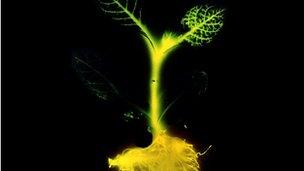Kickstarter crowd gives glowing plant the green light
- Published

A glowing plant that could provide a sustainable light source has caught the imagination of backers on the crowdfunding website Kickstarter.
With a month still to go, the project has raised $243,000 (£157,000). Its initial goal was $65,000.
Backers are promised seeds for glowing plants, although delivery will not be until next May at the earliest.
The "biohacking" team behind the project said that in future trees could act as street lights.
The researchers are keen that their mix of DIY synthetic biology and sustainable lighting remains open-source.
"Inspired by fireflies... our team of Stanford-trained PhDs are using off-the-shelf methods to create real glowing plants in a do-it-yourself bio lab in California," said project leader Antony Evans.
"All of the output from this project will be released open-source, the DNA constructs, the plants etc," it said on its website.
Commercially appealing
The research team, led by synthetic biologist Omri Amirav-Drory and plant scientist Kyle Taylor, aims to transplant a bioluminescence gene into a small plant called Arabidopsis, a member of the mustard family.
The team has chosen this plant as it is easy to experiment with and carries minimal risk for spreading into the wild.
However, it hopes that the same process will work for a rose, which it considers to be more commercially appealing.
The team will work with luciferase, an enzyme common in fireflies as well as some glowing fungi and bacteria.
The researchers have already designed the DNA sequences using software from a company called Genome Compiler, which allows people to easily design genetic sequences.
They will then "print the DNA" and the final stage will be to transfer this to the plants.
'Great inspiration'
Initially the genes are transferred to agrobacteria, increasingly used in genetic engineering because they can transfer DNA between themselves and plants.
This method will only be used for prototypes as the bacteria are plant pests and any use of such organisms is heavily regulated.
For the seeds that will be sent to the public, the team will use a gene gun that effectively coats nanoparticles with DNA and fires them into plants. This method is not subject to regulation.
George Church, a professor of genetics at Harvard Medical School who is backing the project, said that biology could provide great inspiration for more sustainable light sources.
"Biology is very energy-efficient and energy packets are more dense than batteries. Even a weakly glowing flower would be a great icon."
The team is not the first to create glowing plants.
'Pretty enticing'
In 2008 scientists at the University of California created a glowing tobacco plant, using luciferase.
And in 2010 researchers from the University of Cambridge were able to make bacteria glow sufficiently to read by.
Theo Sanderson, a member of that Cambridge team, has blogged about the new attempt.
"Nobody can deny that the idea of walking down a path lit by glowing trees is pretty enticing... what has disappointed me has been the lack of discussion as to what the team actually plan to do with the funds raised, and whether the science stacks up," he said.
"My prediction is that this project will ship plants which have a dimly visible luminescence in a pitch-black room."
- Published24 January 2013
- Published21 February 2013